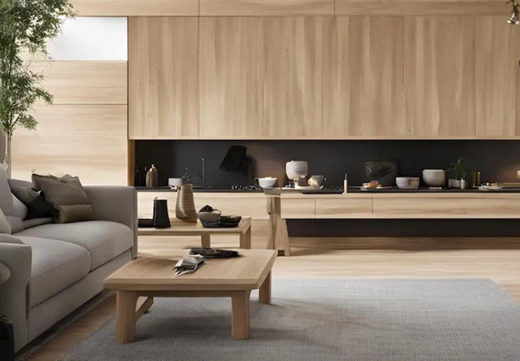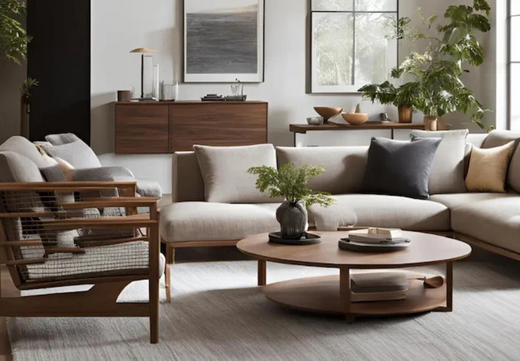Natural materials, particularly oak and beech, play a significant role in modern design and interior decoration. Their exceptional properties, such as durability and aesthetics, make them increasingly popular choices among designers and consumers.
Oak, with its noble structure and variety of shades, including red oak and knot-free oak, attracts attention with its beauty and functionality. In the context of ecology, the use of natural materials like beech and oak contributes to sustainable development. Wood, as a renewable resource, along with its properties, such as resistance to wear, makes it an excellent construction and decorative material.
Therefore, oak and beech are not only aesthetically pleasing but also practical, highlighting their importance in contemporary design.

Natural Materials in Design
Natural materials play a key role in modern design and architecture, bringing harmony and aesthetics to interiors. With the growing ecological awareness, trends are moving towards sustainable development, with raw materials such as wood, clay, and straw being essential elements. Thanks to their unique properties, natural materials are gaining popularity as alternatives to traditional building materials like concrete or steel.
Wood stands out not only for its aesthetic beauty but also for its humidity regulation and minimal carbon footprint. Such materials positively impact living comfort, creating a healthy microclimate in living spaces. As a result, homes built with natural materials contribute to energy cost reduction, which is particularly important in the context of current trends in architecture and design.
It is worth noting that natural materials introduce not only aesthetics but also functionality to interiors. Well-chosen raw materials can significantly enhance the quality of space usage, making them not only an aesthetic asset but also an economic one.
Aesthetics of Natural Materials
The aesthetics of natural materials, particularly wood, are fundamentally important in modern interior design. Wood, including oak and beech, brings unique colors and textures to rooms, creating a cozy atmosphere.
Interiors finished with natural materials gain elegance thanks to the variety of shades and unique grain patterns, making them attractive to both lovers of Scandinavian and traditional styles.

Beech, as a valued wood species, is characterized by a light beige color with subtle pink and cream tones, giving interiors a cozy and elegant appearance. Its smooth, uniform structure with visible grains adds depth and a unique character to furniture and finishing elements. Thanks to its ability to uniformly accept dyes, beech wood offers the possibility to adjust the color to individual preferences, enhancing its aesthetic potential across a wide range of applications.
In the context of ecological interior design, natural materials, including wood, offer not only an attractive appearance but also positively influence the quality of space. The growing interest in ecological solutions has led to the increasing popularity of traditional materials that are more sustainable and eco-friendly.
Benefits of Using Oak in Interior Design
Oak, as a material used in interior arrangements, offers a range of benefits that make it an extremely popular choice. Thanks to its exceptional durability, oak serves not only as an aesthetic but also a functional element in homes and offices. Its natural appearance and density ensure that many oak furnishings will last for years, maintaining their original look and high resistance to damage.

Durability and Resistance of Oak
Oak wood is characterized by exceptional durability, making it suitable for producing furniture and flooring. As a dense and sturdy material, oak is resistant to scratches and mechanical damage.
Thanks to its ability to be refinished, such as sanding or varnishing, oak furniture can have its original luster restored after many years of use. This durability ensures that investing in oak furnishings pays off in the long term.
Visual Aesthetics of Oak
The aesthetics of oak attract the eye and create a cozy atmosphere in any interior. The natural grain of oak wood gives a unique character to different arrangements, from classic to modern.
It pairs well with other materials, such as glass or leather. Oak furniture, thanks to its aesthetic qualities, is an ideal complement to stylish spaces.
The wide range of colors and finishes makes oak versatile and adaptable to various tastes and preferences.
Why Beech is a Popular Choice in Design?
Beech is increasingly being chosen as a material in modern design, thanks to its unique properties. The density and durability of this wood make it ideal for producing furniture and finishing elements.
Beech is gaining popularity because its aesthetic color and subtle grain patterns blend well with various interior styles, making it a versatile material.
Mechanical Properties of Beech
The mechanical properties of beech affect its stability and durability. This wood is highly resistant to damage, making it a preferred choice in high-traffic areas. Thanks to its strength, beech is suitable for both everyday furniture and finishing elements that must withstand intense use. This popularity of beech in design is not accidental but results from a focus on aesthetics and high quality of the material, providing attractive interior arrangement options.
Ecological Aspects of Using Natural Materials
Ecological aspects of using natural materials in design are becoming increasingly important in the context of environmental challenges. Wood, as a renewable resource, contributes to reducing CO2 emissions, promoting sustainable development. Responsible wood sourcing and processing not only protect the environment but also preserve biodiversity.
An important element is also the role that natural materials play in creating a healthy microclimate in rooms. Studies show that wooden furniture, eliminating toxic chemicals, has gained popularity among many customers who value their beneficial impact on health. Ecological aspects of using wood can contribute to improving indoor air quality and regulating humidity.
How Natural Materials Affect the Microclimate of the Interior?
Natural materials, such as oak and beech, play a key role in shaping the interior's microclimate. Thanks to their unique moisture regulation properties, these raw materials contribute to creating a friendly atmosphere in living spaces. Wood has the ability to absorb excess moisture from the air, reducing the risk of mold formation and promoting the health of residents.

Humidity Regulation in Living Spaces
Interiors dominated by natural materials are characterized by a stable level of humidity. The ideal air humidity should be between 40-60%, which is crucial for the comfort of residents and the durability of wooden elements.
Examples of Using Oak and Beech in Modern Design
In today's world, oak and beech are recognized as materials that fit well into modern design. Examples of oak applications can be found both in furniture and architectural elements.
Wooden stairs, often made of oak, play an important role in interior arrangements, bringing elegance and durability. Minimalist projects aptly reflect the aesthetics of contemporary spaces, and oak adds a unique charm to them.
Beech, due to its mechanical properties and hardness, also finds many applications in modern design. Furniture made of beech is a perfect example of the harmonious combination of aesthetics and functionality. Various colors and material options available emphasize the versatility of this wood in both classic and modern arrangements.


